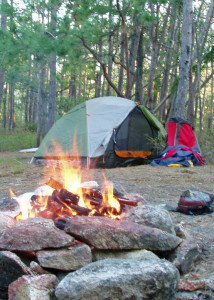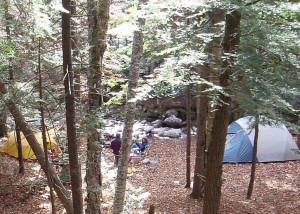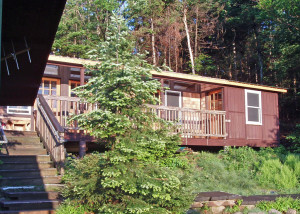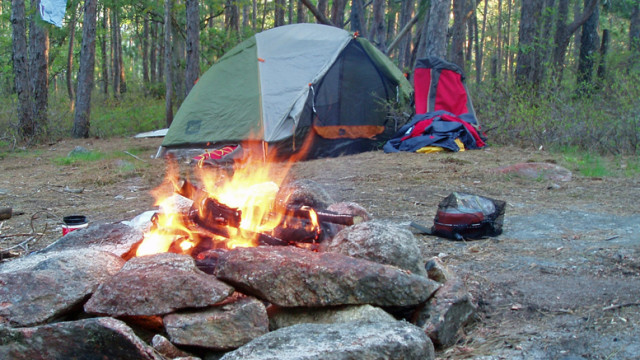
Recent articles we’ve posted on winter camping have prompted some readers to write and ask “Are you crazy?,” usually in somewhat gentler terms than that. The answer is, of course, “yes!, but not completely insane.” Insanity would be to jump into cold weather camping without experience or a good mentor.
I’m a big believer in incremental learning, taking new things one step at a time. Camping is one of them. If you are new to sleeping in a tent—or are introducing someone to it—it’s probably best not to start with a six-month trek on the Appalachian Trail.
There are lots of increments to “Camping,” but the eventual goal is to be able to put all the stuff you need for comfort, hygiene and safety onto your back, boat, or bike and go wherever you please under your own power. Sounds nice, doesn’t it? It is, and here’s how to get started.
How To Camp: Learning In Simple, Safe Steps
How To Camp Step 1: Arm yourself with information. Find an experienced camper who can teach you. That’s absolutely the best way to learn. If you don’t know anyone, join one of the organizations that promote outdoor activities (I’ll put a resource list below.) Read books and magazines and on-line forums and articles, and visit outdoor shops where the store personnel are experienced. But be cautious about who you trust; not every self-styled expert is experienced or reliable . . . If you have specific questions, contact me and I’ll be happy to help if I can.

How To Camp Step 2: Assemble your equipment. I mean that literally. First gather everything on your backpacking checklist, then try everything out at home before you head out to go camping. The time to try setting up a tent or starting a stove for the first time is NOT when you need it. A wilderness campsite is also an inconvenient place to find that your self-inflating air mattress won’t hold air . . . If you don’t have equipment and can’t borrow it, consider renting. I’ve often rented gear I need but don’t have from EMS, but there are other sources including REI and some on-line companies like Lower Gear.
How To Camp Step 3: Start easy. Personally I’m not a big fan of car-access camping, but roadside campsites are (next to your own back yard) absolutely the best place to do a first campout on your own. Unless you are traveling with someone who knows what they are doing, you should always start your camping career near your car. Having the car gives you the ability to replace something critical you left at home, to get instruction, replacement or repair for something that isn’t working, and ultimately, the ability to retreat if things get uncomfortable. Besides, most roadside campsite have “indoor plumbing” which allays one major fear of camping newbies.
How To Camp Step 4: Leave security in stages. For your first adventure “away” from the road. I’m in favor of what I call “The Great Quarter Mile Backpacking Trip” (though a quarter mile is a totally arbitrary number). There are places in the Adirondacks of New York, the Green Mountain National Forest of Vermont, the White Mountain National Forest in New Hampshire and in the North Maine Woods, and some private lands where you can camp close to but not right on the road. Again, you have the security of having your car close by and, sometimes, an outhouse for “facilities, but you still have to pack up your gear into a backpack or into a canoe or kayak and carry it some distance before setting up your camp. It’s great practice and the perfect way to start your wilderness camping career.
How To Camp: Quarter-Mile Campsites
This past winter I discovered Merck Forest in southwestern Vermont, which has a number of tent sites a short distance from roads (and a number of backcountry cabin as well). This would be an ideal place for a first “away from the road getaway
Another place is at the AMC’s Cardigan Mountain Lodge where they have campsites a short distance from the lodge itself.
How To Camp: The Hut Alternative

Before she met me, my sweetheart Marilyn’s idea of “camping” was a 3-star hotel. Now she’ll happily throw on a backpack full of gear and head out overnight with me (almost) any time I suggest it. (Hint to guys who want their sweethearts to enjoy camping: I don’t suggest it unless I’m confident conditions are such that she’ll enjoy it! The same goes for older kids. Little ones take to camping as naturally as they take to mud puddles,)
But her first wilderness “overnight” wasn’t in a tent. Instead, I took her to Lonesome Lake Hut, the easiest to reach of the Appalachian Mountain Club’s hut system. There, she had the adventure of hiking away from the road, but the security of four walls, food you don’t have to carry or cook yourself, a roof, composting toilets and other people around. Hut hiking means no heavy backpack, and I highly recommend it for a “first overnight in the woods.”
The AMC huts now have some competition in Maine. Maine Huts And Trails has opened four of its planned 12 backcountry huts.
How To Camp: Resources
Chances are any of these organizations can help get you started in safe camping wither through an organized class or by connecting you with like-minded folks
Appalachian Mountain Club. Note they have state and regional chapters that are a tremendous resource.
If you know any others, please drop me a note.


